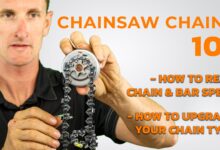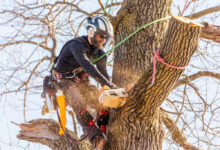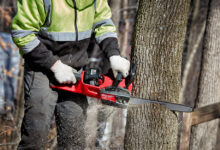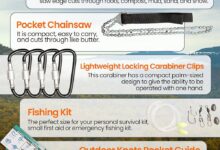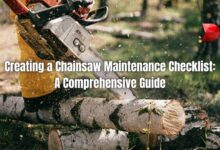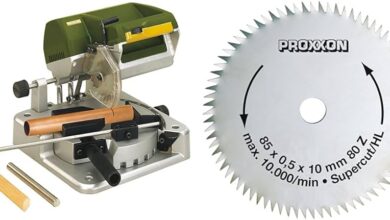How Chainsaw Kickback Will Kill You if You Don’t Avoid It
Kickback is one of the most dangerous hazards associated with using a chainsaw. It occurs when the tip of the chainsaw bar makes contact with an object, causing the saw to be thrown violently back towards the operator. This can result in serious injuries, including cuts, bruises, and even death.
There are several things you can do to avoid chainsaw kickback. First, always make sure that the chainsaw is properly maintained and sharpened. A dull chain is more likely to bind and cause kickback. Second, always use a firm grip on the chainsaw and keep both hands on the handles at all times. Third, be aware of the position of the tip of the chainsaw bar and avoid cutting near obstacles. Fourth, never cut above shoulder height. Fifth, never cut with the tip of the chainsaw bar. Sixth, always use a safety helmet, gloves, and eye protection when operating a chainsaw.
If you do experience chainsaw kickback, the most important thing to do is to remain calm and in control. Do not let go of the chainsaw, as this could cause it to fly out of control. Instead, try to guide the chainsaw away from your body and allow it to stop on its own.
Chainsaw kickback is a serious hazard, but it can be avoided by following these simple tips. By taking these precautions, you can help to ensure your safety when operating a chainsaw.
The Anatomy of Chainsaw Kickback
Chainsaw kickback occurs when the tip of the chainsaw bar makes contact with an object, causing the saw to be thrown violently back towards the operator. This can happen when the saw is being used to cut through branches, logs, or other objects. The force of the kickback can be strong enough to cause serious injuries, including cuts, bruises, and even death.
There are several factors that can contribute to chainsaw kickback, including:
- A dull chain
- A loose chain
- A chain that is not properly tensioned
- A saw that is not properly maintained
- An operator who is not properly trained
By understanding the causes of chainsaw kickback, you can take steps to avoid this dangerous hazard.
The Dangers of Chainsaw Kickback
Chainsaw kickback can be a very dangerous hazard. It can cause serious injuries, including:
- Cuts
- Bruises
- Broken bones
- Eye injuries
- Head injuries
- Death
In some cases, chainsaw kickback can even be fatal. It is important to be aware of the dangers of chainsaw kickback and to take steps to avoid it.
How to Avoid Chainsaw Kickback
There are several things you can do to avoid chainsaw kickback, including:
- Always make sure that the chainsaw is properly maintained and sharpened.
- Always use a firm grip on the chainsaw and keep both hands on the handles at all times.
- Be aware of the position of the tip of the chainsaw bar and avoid cutting near obstacles.
- Never cut above shoulder height.
- Never cut with the tip of the chainsaw bar.
- Always use a safety helmet, gloves, and eye protection when operating a chainsaw.
By following these simple tips, you can help to ensure your safety when operating a chainsaw.
What to Do If You Experience Chainsaw Kickback
If you do experience chainsaw kickback, the most important thing to do is to remain calm and in control. Do not let go of the chainsaw, as this could cause it to fly out of control. Instead, try to guide the chainsaw away from your body and allow it to stop on its own.
Once the chainsaw has stopped, inspect it for damage. If the saw is damaged, do not use it again until it has been repaired.
If you are injured as a result of chainsaw kickback, seek medical attention immediately.
Chainsaw Kickback Safety Features
Some chainsaws are equipped with safety features that can help to prevent kickback. These features include:
- Anti-kickback chain
- Chain brake
- Hand guard
Anti-kickback chains are designed to reduce the risk of kickback by reducing the amount of force that is transferred to the saw when the tip of the bar makes contact with an object. Chain brakes are designed to stop the chain from rotating if the saw experiences kickback. Hand guards are designed to protect the operator’s hands from being struck by the chainsaw chain.
These safety features can help to make chainsaws safer to use, but they are not foolproof. It is important to always follow the safety precautions listed above when operating a chainsaw.
FAQs About Chainsaw Kickback
Here are some frequently asked questions about chainsaw kickback:
- What is chainsaw kickback?
- What are the causes of chainsaw kickback?
- What are the dangers of chainsaw kickback?
- How can I avoid chainsaw kickback?
- What should I do if I experience chainsaw kickback?
- What are chainsaw kickback safety features?
- How can I choose the right chainsaw for my needs?
By understanding the causes and dangers of chainsaw kickback, you can take steps to avoid this dangerous hazard. Always follow the safety precautions listed above when operating a chainsaw, and be sure to choose a saw that is equipped with safety features. By taking these precautions, you can help to ensure your safety when operating a chainsaw.
Conclusion
Chainsaw kickback is a serious hazard, but it can be avoided by following these simple tips. By taking these precautions, you can help to ensure your safety when operating a chainsaw.
Remember, chainsaw kickback is a preventable hazard. By following the safety precautions listed above, you can help to ensure your safety when operating a chainsaw.
If you are ever unsure about how to safely operate a chainsaw, be sure to consult with a qualified professional. They can provide you with the training and advice you need to safely operate a chainsaw.
Disclaimer
The information provided in this article is for general informational purposes only and does not constitute professional advice. It is essential to always consult with a qualified professional before making any decisions about your health or safety.

